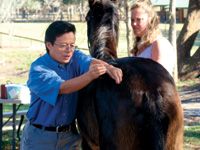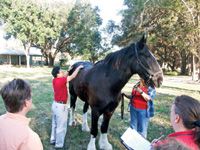Ancient science aids modern equine medicine
A healing science that dates back thousands of years in another culture has gained acceptance in recent years as a method of diagnosing and treating lameness in horses.
A healing science that dates back thousands of years in another culture has gained acceptance steadily in recent years as a method of diagnosing and treating lameness in horses.

Pinpointing the trouble spot: Dr. Huisheng Xie demonstrates dry-needle acupuncture (2.5-in. to 6-in. needles) on a 12-year-old mare to treat hinderquarter weakness at the wet lab of the Chi Institute Advanced Equine Acupuncture Class 2009.
"When administered by a properly trained veterinarian, acupuncture is one of the safest forms of medical treatment, and is said to shorten the healing process by half," says Rhonda Rathgeber, DVM, PhD, an equine acupuncturist at the Hagyard Equine Medical Institute in Lexington, Ky.
Acupuncture concentrates on the animal as an "energetic being" within its environment, according to Huisheng Xie, DVM, PhD, clinical associate professor at the University of Florida, who says the practice of Traditional Chinese Veterinary Medicine (TCVM/TCM) in horses dates back to 974 to 928 B.C., and to 1608 A.D. as a means of diagnosing and treating equine lameness.
TCM emphasizes the "Qi," or total energy of the horse, which passes along a network of meridians or channels similar to an electric current. Qi maintains balance in bodily functions, Xie explains. When disease or injury are present, this energy or the body's homeostasis is in imbalance, and that disruption short-circuits the body, causing malfunction.

Treating lameness: Dr. Huisheng Xie examines an 11-year-old stallion with an acupuncture needle in treatment of lameness at the wet lab of the Chi Institute Veterinary Herbal Medicine Kidney Module 2007.
TCVM practitioners state the rule, "Where there is pain, there must be blockage of Qi flow, and where there is free flow of Qi there is no pain," says Xie.
Diagnosing lameness
Some veterinarians may use sensitivity at the acupuncture points to localize lameness, and then treat the problem with Western methods or with acupuncture therapy.
"The diagnostic acupoints lead us to a definitive diagnosis," says Marvin Cain, DVM, veterinary acupuncturist in Union, Ky.
"These have all been confirmed either ultrasonically or radiographically, so they're not theoretical diagnostics. They have been verified by both what the horse shows us, and with radiographs and other diagnostic modalities to confirm what we find. With acupuncture, you can pinpoint lameness conditions just as well, if not better; and it is just as accurate, and even more helpful, than the other modalities because of cost," Cain says.
"Palpation is a neglected art anymore," he adds. "Veterinarians don't palpate or auscultate to diagnose, but depend upon on the various technologies which often are very misleading. But the body doesn't lie, especially when we can go back and use some of these techniques (e.g., scintigraphy) to verify. The advantage is that acupuncture is far less costly to the owner, and the accuracy is such that if we pick up a knee for a carpal joint we can tell using acupuncture whether it's a third carpal or a radial carpal, and it negates the necessity of multiple radiographs."
An equine veterinarian successfully used a TCM examination to pinpoint fetlock pain in 327 racehorses, Rathgeber says. "He used a thorough TCM diagnostic exam to evaluate each horse. The points specific to fetlock pain were sensitive in every horse. The sensitive points disappeared after the suspicious fetlock joint was blocked with an intra-articular joint block. The blocks eliminate the pain and therefore eliminate the sensitivity in the acupoint."
A certified acupuncture practitioner will palpate acupoints and determine the horse's reaction, Rathgeber explains. "The central nervous system reflects a map of pain based on the meridians or channels. When pain is present, inflammation, an increase or decrease in circulation and increased or decreased muscle tone also are present. Therefore when the meridians are palpated, the examiner will notice a difference in the quality of the tissue. The practitioner applies a light, consistent pressure from point to point and notes the reaction."
The information gained from the acupuncture exam can help decide what area to palpate, flex or radiograph, Rathgeber says. "The TCM examination is a diagnostic tool that can be used to its fullest potential in conjunction with a thorough Western physical examination."
For example, one might locate a stifle problem via acupuncture, then the practitioner would block, ultrasound, radiograph and possibly treat the inside of the stifle to complete the examination, Rathgeber says.
"If there is obstruction, the point is very reactive. The acupoints may be firm, yielding to pressure, tightening under pressure, warm, cold, and so on. A reactive point might trigger a muscle spasm or an evasive or aggressive reaction. Some horses will feel so much pain when pressure is applied that they will bite or kick. Generally, a reaction to light pressure indicates a more acute condition, and response to deep pressure indicates a long-standing condition."
TCM can play a key role in diagnosis of obscure lameness by identifying syndromes through patterns of sensitivity at certain points, Rathgeber explains.
The veterinary acupuncturist can translate the map of the acupoint pathways and determine the source of the pain. "Diagnostic acupuncture should be used with other modalities, including nerve blocks, flexion tests, ultrasound, radiography and nuclear scintigraphy to achieve the best diagnosis and the best possible treatment," Rathgeber says.
Another practitioner agrees. "I find acupuncture an extremely beneficial tool for both diagnostics as well as therapeutics," says Allen M. Schoen, DVM, MS, veterinary acupuncturist in Sherman, Conn.
"I look for patterns of reactive acupuncture points. Certain patterns reflect the way a horse compensates for certain lameness issues. There are predictable patterns for hock problems or foot problems ... and for chronic back problems, saddle issues, for many lameness issues. The level of reactivity at different points gives you an indication of whether something is a primary issue or a secondary issue."
"We use it (acupuncture) almost exclusively for diagnosis," adds Cletus Vonderwell, DVM, semi-retired veterinary acupuncturist in Ohio who recently received honorary lifetime membership in the International Veterinary Acupuncture Society.
"Historically, when we saw (race)horses, we did not want to know how they'd been racing or what they'd been doing right or wrong on the track. We preferred to watch them on the track, go over them (with an acupuncture exam) and then tell the trainer what the horse was doing wrong. I did not want a history on the horse, but I wanted the horse to tell me where he was hurting. When you're right it looks pretty impressive; when you're not you don't look too smart," says Vonderwall.
"Acupuncture enables me to give a more definitive diagnosis, in my opinion, no question about it," he adds.
Treatment
For treating lameness, "acupuncture will relieve the muscle tension and pain and facilitate healing, " says Rathgeber. "It is used to treat such lameness-causing conditions as navicular syndrome, sidebone, ringbone, laminitis, bone spavin and all types of degenerative joint disease."
The results vary, and usually the more chronic conditions require more treatments before improvement is seen, while the acute or more recently acquired problems need less treatment. Other lameness issues that can be treated with acupuncture include neck pain, short-stepping, dragging one toe and stumbling.
Acupuncture stimulates certain reflex points to allow the body to balance energy and heal the disease, says Rathgeber. The acupuncture points are located along the meridians and serve as booster points, stations or regulators of energy flow. The needles stimulate the electrical system and interact with the body's metabolites — humoral, hormonal and the energy of the nervous system, including endorphins, hormones, cortisol, electrical metabolites.
Acupuncture stimulation will relieve muscle spasms and allow injuries to heal more readily by increasing blood flow and the body's ability to remove toxins from the site of injury. Acupuncture, as it releases endorphins and cortisol, can reduce pain and swelling and help the body's immune system, says Rathgeber.
The horse has 361 points on its body, stimulation of which by acupuncture can produce a therapeutic effect. "The trained equine acupuncturist must learn the location of the points, those that lie along the meridians and pathways of the peripheral nerves," Rathgeber explains. The points correspond to known neural structures, motor nerves, superficial nerves, nerve plexi and muscle-tendon junctions called golgi tendon organs.
"Acupuncture uses these neural structures to achieve its therapeutic effects," says Rathgeber. "Acupuncture is mediated in part through the nervous system, including both the somatic and the autonomic nervous systems. Especially regarding lameness issues, the somatic nervous system includes nerves that control voluntary muscular movement and allow the body to be aware of its movements."
There is no one treatment that has all the answers, no one approach that is a panacea, Schoen says. "Acupuncture is an excellent adjunct to our conventional medicine and therapy. In my practice, I combine it with chiropractic techniques. The two are quite synergistic, one working more on the skeletal issues and one mostly on the muscular issues. Together the synergy of them is just phenomenal, one beneficial approach."
Acupuncture may be most beneficial for chronic back problems and saddle issues, says Schoen. "Lots of times the conventional veterinarian will treat a primary joint, injecting coffin joints or knees, hocks or stifles. The thing with acupuncture is that the horse has been compensating for those joint issues elsewhere. Often what you hear is that 'the joints were injected, my horse has definitely improved, but it's still not back to normal.' That's because in the past we haven't looked at the secondary, compensatory issues in the neck, the back or elsewhere. So acupuncture diagnostically helps identify those secondary, compensatory areas."
Vonderwell agrees, saying that acupuncture diagnosis and treatment is not the answer for all lameness problems in horses,
"It is not for many orthopedic problems, and does not eliminate the need to used radiographs to aid in diagnosis. But it is a valuable addition."
Kane is a Seattle author, researcher and consultant in animal nutrition, physiology and veterinary medicine, with a background in horses, pets and livestock.
Podcast CE: A Surgeon’s Perspective on Current Trends for the Management of Osteoarthritis, Part 1
May 17th 2024David L. Dycus, DVM, MS, CCRP, DACVS joins Adam Christman, DVM, MBA, to discuss a proactive approach to the diagnosis of osteoarthritis and the best tools for general practice.
Listen